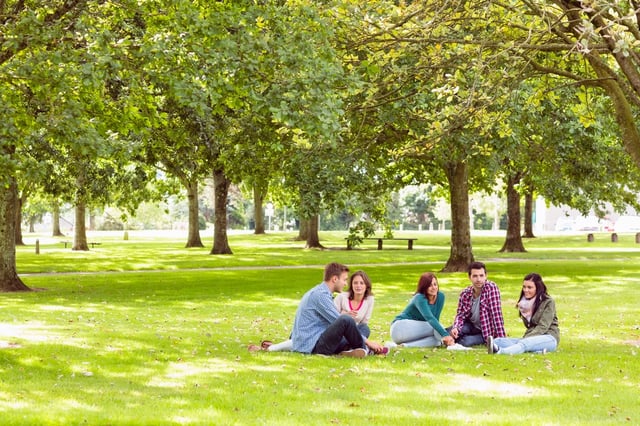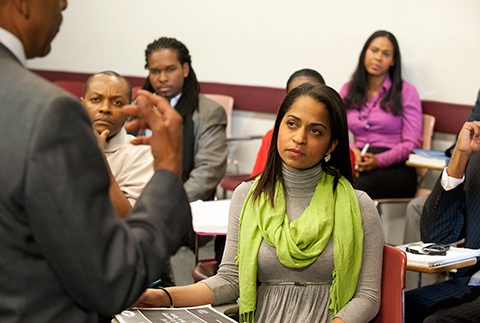Campus Diversity: Safe Spaces Vs. Brave Spaces

Political ideology, social beliefs, triggering events and shifts in the power structure have the populations at large clearly divided among strong partisan lines. Contemporary communication methods like social media where voices on any side of a debate can be amplified by all the participants in said debate help define these divides even more. College campuses are not immune to this environment, and because campuses have traditionally been a format for the expression and exchange of ideas, these beliefs can often time be on full display in common areas and lecture halls throughout the school. In response to this phenomenon, a number of schools have deemed certain areas of the campus and in some instances the entire campus as a "Safe Space".
The loose definition of which is an area where a student(s) can occupy learn and thrive without being encountered by speech or action that they or society at large may deem offensive. The proliferation of Safe spaces on campuses all over the US and backlash from those who believe providing these type of spaces only help divide even more have led some university officials to also consider areas known as "Brave Spaces". Brave Spaces would be loosely defined as designated areas where ideas and philosophies from all viewpoints can be shared in a civilized manner with the implication that although you may not agree with the viewpoint or even find it offensive, you acknowledge the right of individuals or groups to express said point without interruption or disturbance.
College officials who are striving towards or struggling with campus diversity and inclusion must consider a number of factors when establishing safe or brave spaces on campus including but not limited to groups of students current and perspective who may be included or excluded by these designations. Ground rules for both types of spaces. They must also consider a concurrent plan of bridging the divide while creating these spaces for people to be heard and or feel safe.
Campus Diversity and inclusion is a goal for a lot of college campuses, and when establishing safe or brave spaces must keep their D&I goals in mind. Specifically when it comes to establishing these spaces and who they're designated for. A good rule of thumb is to have rules for these spaces in terms of who can use the space along lines of similar thinking as opposed to other factors such as race, or gender. Especially when it comes to "safe spaces". Designations based on race and gender even when well intention still provide barriers to access or a feeling of being ostracized if you're not automatically part of the defined group. If the occupation of the space or participation in activities in the space is based on more obtuse identifiers like mindset, value system, political beliefs/agenda than you're less likely to exclude any groups based on factors they have no control over such as race and gender. At least in the initial establishment of these spaces, You don't create isolation based on these constructs that are already divisive.
Non-Traditional Student Recruitment & Grassroots Marketing Case Study
Another rule of thumb when championing diversity and inclusion and establishing spaces for the equal exchange of ideas is setting ground rules. Think of this as establishing a baseline of civility and respect for each designation. The rules should be based on ensuring participants physical well being and prepping them for what to expect when participating in the spaces or even within close proximity. Establishing a baseline of appropriate behavior is a message from the institution to the students current and perspective, faculty and staff, that you have skin in the game in terms of fostering a diverse inclusive environment where an exchange of ideas with people from all different walks of life is encouraged. This can go a long way in public relations and recruitment efforts. If your institution is known for addressing the elephant in the room head on and looking for solutions that are much more attractive to the audience at large than an institution who see's challenges faced by the student body and sticks it's head in the sand to avoid dealing with it.

Safe space or brave space is not the end all be all when it comes to a plan for diversity and inclusion on campus. These approaches should be conduits used by people with opposing views to traverse with the end result being reaching a common ground. This isn't to suggest the college be solely responsible for changing larger societal views, but nobody denies higher ed's role in this ongoing debate. If you can use these tactics to bridge that gap not only will you be attractive to prospective students for years to come. You'll also be held up as an example of open dialogue, unity, and equality that people and institutions worldwide will emulate, which is an envious position to be in for any school.
Read our Ultimate Guide to Diversity & Inclusion in Student Recruitment
Using these spaces as a conduit to tackling larger issues, establishing ground rules for safe and brave spaces, and also recognizing the groups and individual types that would be attracted to each type of space are solid action steps to promote and foster an environment of diversity and inclusion on campus and set as solid example outside campus. Have you seen or implemented safe or brave space programs on your campus? Feel free to share those experiences and outcomes with us in the comment section below, your feedback is appreciated.
Share this
You May Also Like
These Related Stories

Diversity Infusion: 6 Tools For a More Diverse College Campus

Non-Traditional Student Recruitment & Grassroots Marketing Case Study



